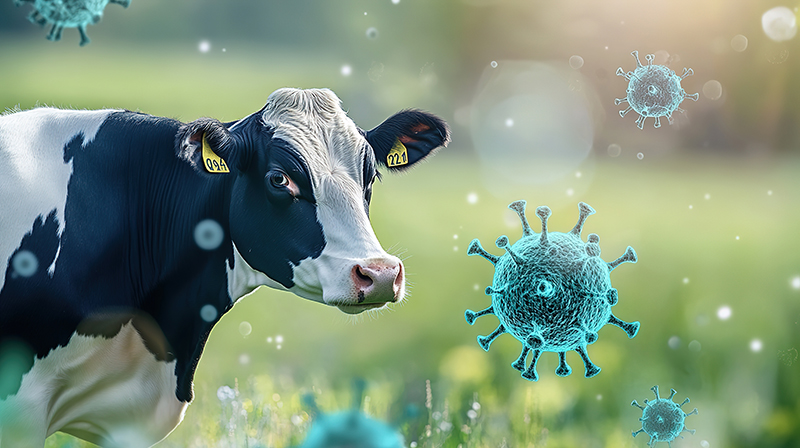Marcelo Wallau, UF/IFAS Forage Extension Specialist, Ashley Kanobroski (UF/IFAS Agronomy Department, Forage Team), Olivia Maule (CALS Faculty Instructional Resources and Support Team), Benjamin Anderson, Assistant Professor in the UF Department of Environmental and Global Health, Cindy Sanders, UF/IFAS Alachua County Extension Director, and Colleen Larson, UF/IFAS Regional Specialized Agent in Dairy Systems.
Recent detections of H5N1 avian influenza in dairy cattle have raised new concerns across the livestock industry. Once considered primarily a poultry disease, H5N1 has evolved, and cases in mammals—including dairy cows—are now confirmed in 17 states, affecting nearly 1,000 herds. While Florida has not reported any cases in dairy cattle to date, there have been many reports of H5N1 in wild birds and mammals (dolphins). According to the Center for Disease Control’s USDA Reported H5N1 Bird Flu Detections in Wild Birds, there are 70 cases of transmission to humans, mostly related to dairy cattle.
–
To discuss the impact of the H5N1 bird flu to the livestock industry, the Cow Talks, podcast team brought in Dr. Benjamin Anderson, Assistant Professor in the Department of Environmental and Global Health at the University of Florida, and Dr. Cindy Sanders, County Extension Director, UF/IFAS Extension Alachua County, and Colleen Larson, Dairy Systems Regional Specialized Agent, UF/IFAS Extension Okeechobee County. We recorded two episodes to discuss how this disease is changing, what it means for producers, and the best strategies for prevention and response.
Cow Talks episode, Understanding the Spread of H5N1: Impacts on Poultry and Dairy with Colleen Larson
Cow Talks episode, From Fairgrounds to Farms: Mitigating Avian Flu Risks in Dairy Cattle with Dr. Benjamin Anderson and Dr. Cindy Sanders
The strain of H5N1 currently circulating can more easily infect mammals, with dairy cows being particularly vulnerable due to the virus’s ability to infect and replicate in mammary tissue. There are now outbreaks confirmed in 17 states, affecting nearly 1,000 herds. Infected cows often produce abnormal milk and may experience up to a 30% drop in production. While often not deadly, many cows do not recover to prior production levels, resulting in culling. Though this has raised concern among consumers, pasteurization continues to be an effective safeguard against the virus, and milk from commercial sources remains safe. While no human cases have been linked to dairy consumption, the emergence of the virus in dairy cattle adds complexity to managing animal health and public confidence. As such, we emphasize the importance of consuming pasteurized milk from known and reliable sources.
Beyond the dairy sector, there are implications for the broader livestock industry. For domestic poultry, the current mitigation strategy is culling the entire flock. Since the beginning of this recent outbreak in 2022, over 168 million birds in commercial and backyard poultry operations have been affected, and 623 commercial and 753 backyard flocks have been affected in all 50 states, resulting in over 148 million birds euthanized. Due to a more concentrated number of H1N1 outbreaks among egg layer operations in the past 4 months, the price of eggs has increased after a significant drop in total market supply.
Another source of concern is where animals are commingled—such as at county fairs and livestock shows. These events can facilitate the spread of pathogens between animals and across species. Dr. Sanders emphasized the importance of enhancing biosecurity protocols, especially around animal movement and public interaction. While H1N1 has not impacted beef cattle operations, enhancing biosecurity is beneficial to protect against other infectious disease threats.
Biosecurity measures are the primary line of defense. On dairy farms, steps such as limiting farm access, designating clean and dirty zones, monitoring milk quality, and reducing unnecessary animal movement are already in place in many operations. These practices are just as important for small-scale and youth livestock producers, especially during fair season. Another concern is for small mixed livestock operations, especially when animals are commingled. Extension agents can assist with adapting these practices to different farm sizes and production systems.
Monitoring and communication are equally important. Producers should work closely with veterinarians and extension personnel when signs of illness appear—such as abnormal milk, sudden drops in production, or respiratory symptoms. As Colleen Larson highlighted, staying grounded in science-based information helps producers respond effectively and reassures consumers. With a coordinated effort across agricultural and public health sectors, the livestock industry can reduce the risk of widespread transmission and maintain safe, healthy food systems.
–
Resources for More Information
For those seeking additional information on H5N1 and how to mitigate its impact, the episode directs listeners to several helpful resources:
- H5N1 Update and Developing Biosecurity Protocols: Watch the Seminar
- Southeastern Coastal Center for Agricultural Health and Safety: Visit the Website
- 2025 Southeastern Hay Contest Sets New Records - October 24, 2025
- 2025 Cool-Season Forage Official UF/IFAS Variety Trial Results - September 5, 2025
- Revisiting Crop–Livestock Integration in the Southeastern United States - September 5, 2025

